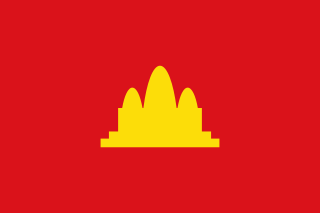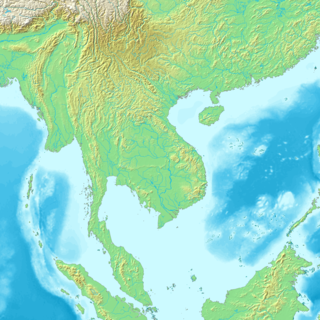
The Khmer Rouge is the name that was popularly given to members of the Communist Party of Kampuchea (CPK) and by extension to the regime through which the CPK ruled Cambodia between 1975 and 1979. The name was coined in the 1960s by then Chief of State Norodom Sihanouk to describe his country's heterogeneous, communist-led dissidents, with whom he allied after his 1970 overthrow.

Phnom Penh is the capital and most populous city of Cambodia. It has been the national capital since the French protectorate of Cambodia and has grown to become the nation's primate city and its economic, industrial, and cultural centre. Before Phnom Penh became capital city, Oudong was the capital of the country.

Mainland Southeast Asia is the continental portion of Southeast Asia. It lies east of the Indian subcontinent and south of Mainland China and is bordered by the Indian Ocean to the west and the Pacific Ocean to the east. It includes the countries of Cambodia, Laos, Myanmar, Thailand, Vietnam, and Peninsular Malaysia.

Angkor Wat is a Hindu-Buddhist temple complex in Cambodia. Located on a site measuring 162.6 hectares within the ancient Khmer capital city of Angkor, it is considered as the largest religious structure in the world by Guinness World Records. Originally constructed as a Hindu temple dedicated to the deity Vishnu, it was gradually transformed into a Buddhist temple towards the end of the century.

Cambodia, officially the Kingdom of Cambodia, is a country in Mainland Southeast Asia. Cambodia borders Thailand to the northwest, Laos to the north, Vietnam to the east, and has a coastline along the Gulf of Thailand on the southwest. Cambodia spans an area of 181,035 square kilometres, and has a population of about 17 million. Its capital and most populous city is Phnom Penh.

Samdech Hun Sen is a Cambodian politician, and former army general who currently serves as the president of the Senate. He previously served as the prime minister of Cambodia from 1985 to 2023. Hun Sen is the longest-serving head of government in Cambodia's history. He is the president of the Cambodian People's Party (CPP), which has governed Cambodia since 1979, and has served as a member of the Senate since 2024. His full honorary title is Samdech Akka Moha Sena Padei Techo Hun Sen.
The Cambodia national association football team represents Cambodia in association football, and is administered by the Football Federation of Cambodia (FFC).

The Khmer people are an Austroasiatic ethnic group native to Cambodia. They comprise over 95% of Cambodia's population of 17 million.They speak the Khmer language, which is part of the larger Austroasiatic-language family alongside Mon and Vietnamese.

Stichophthalma nourmahal, is a South Asian butterfly that belongs to the Morphinae subfamily of the brush-footed butterflies family.

Stichophthalma sparta, the Manipur jungle queen, is a butterfly found in South Asia that belongs to the Morphinae subfamily of the brush-footed butterflies family.

The Royal Cambodian Air Force is the branch of the Royal Cambodian Armed Forces which is charged with operating all military aircraft in Cambodia.
Administrative divisions of the Kingdom of Cambodia have several levels. Cambodia is divided into 24 provinces and the special administrative unit and capital of Phnom Penh. Though a different administrative unit, Phnom Penh is at provincial level, so de facto Cambodia has 25 provinces and municipalities.

Amathusiini is a tribe of the nymphalid butterfly subfamily Morphinae. They are large butterflies. They are sometimes treated as a distinct subfamily Amathusiinae or family Amathusiidae.

Stichophthalma godfreyi is a butterfly of the family Nymphalidae. It is found in scattered areas in South-East Asia, including Burma and Thailand.
Women in Cambodia, due to the influence of the dominant Khmer culture, are traditionally expected to be modest and soft-spoken. They are to be well-mannered, industrious, and hold a sense of belonging to the household. It is expected that they act as the family's caregivers and caretakers, financial administrators, and serve as the "preserver of the home". As financial administrators, women can be identified as having household authority at the familial level. Khmer women are expected to maintain virginity until marriage, become faithful wives, and act as advisors to their husbands. Women in Cambodia have also be known as “light” walkers-- "light" walking and refinement of the Khmer women is further described as being "quiet in […] movements that one cannot hear the sound of their silk skirt rustling".

Stichophthalma louisa is a species of butterfly in the family Nymphalidae. It is found in Asia.

The Cambodian genocide was the systematic persecution and killing of Cambodian citizens by the Khmer Rouge under the leadership of Prime Minister of Democratic Kampuchea, Pol Pot. It resulted in the deaths of 1.5 to 2 million people from 1975 to 1979, nearly 25% of Cambodia's population in 1975.
Institut Pasteur du Cambodge is a medical research centre and public health institute in Phnom Penh, Cambodia. It is part of the Pasteur Institute's international network of health centres and is partnered with the Ministry of Health. It was first established in 1953 and reopened in 1992 after the 1991 Paris Peace Agreements.














